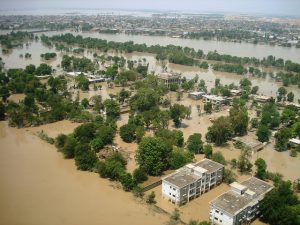On April 26, a mini tornado hit Peshawar, the capital of Pakistan’s Khyber Pakhtunkhwa province, killing as many as 45 people and injuring over 200. The freakish weather was brought on by a sudden rise in temperature, leading to the westerly wave that produces rain coming in contact with the hot surface, say climatologists. This shift in weather pattern, they warn, is a sign of more such events in the future and the government must evaluate urban growth and make appropriate mitigation plans.
It is the new normal, said Ghulam Rasul, the chief meteorologist at the Pakistan Meteorological Department (PMD) while analysing the “twister”. “It is not a matter of if but when the disaster strikes next,” he told thethirdpole.net and added, “Our cities need to brace for similar events.”
The strong wind accompanying the storm blew at 110 kilometres per hour and in its wake brought showers measuring 60 mm. “The downpour was not that much, but the intensity was,” he admitted, adding that nearly 45 mm of that rain fell in just half hour.
The met department’s last weather forecast on April 17 had predicted “scattered rains-thundershowers in upper parts of the country during next 2-3 days” but not a tornado. Rasul said no one can predict this anywhere in the world, “not even in developed countries”.
The storm wreaked havoc. Homes collapsed, trees and electric poles were uprooted and fell on structures. The Pakistani Army and rescue agencies began relief operations shortly afterwards. For his part, Prime Minister Nawaz Sharif made the right sounding noises as he always does – announcing Rs.300,000 (about US$3,000) for each deceased and Rs.10,000 (US $100) for each injured person.
The tornado showed that the “impact of climate change is beginning to be more visible in Pakistan”, Aleemul Hassan, PMD deputy director, said at a press conference.
Abnormal weather patterns had been observed in the country earlier in February and March. While heavy and continuous downpours with thunder and hailstorms in Punjab province damaged the wheat crop, Balochistan and Kashmir witnessed heavy rains and flash floods.
“How many more times do we have to send alerts regarding divergence in weather patterns before those at the helm begin to take notice?” said Rasul, recalling last year’s summer monsoons. “July and August were unusually dry but the downpour in the three days of September more than compensated for the previous two dry months.”
Rasul said it was time governments took a long and serious look into the way cities were growing.
For its part, Sharif’s government has done some soul searching and upgraded the climate change division to a ministry though opinion remains divided on the move.
“What needs to be emphasised is to invest in climate resilient infrastructure, to build better; where building standards are adhered to and where sewerage system is planned on scientific lines,” said Rasul pointing to the burgeoning housing societies where even as little as 15 to 20mm of rainfall turns the entire residential area into a cesspool.
Lahore and Karachi vulnerable
The port city of Karachi, capital of Sindh province and the country’s largest metropolis with a population of approximately 20 million, also has a history of flooding whenever it rains. Most town planners blame the informal settlements and housing schemes that have encroached upon flood plains along natural drains. They say there is no effective policy to prevent settlements in the riverbeds and encroachments on drainage channels.
Compared to Karachi, Lahore seemed to have good drainage. But that’s all in the past. Last year’s heavy downpour that flooded the country’s second largest city in the Punjab province with a population of 10 million showed that it was unable to take the load of so many. The old drainage system based on the now dog-eared Master Plan of 1975 breathed its last and how could it not. Poor infrastructure and blocked drains magnified the flood damage.
“Each province has a planning commission that looks into how cities are to be developed but in my 25 years of working life, I have never once seen or heard any of these offices consulting climate scientists,” pointed out Rasul.
A similar apathy is reflected in the National Climate Change Policy drafted in 2011 but approved in 2012. It is, according to Farhan Anwar, an urban planning and environmental management consultant and technical director of the Karachi-based Sustainable Initiatives, a “total disaster”.
“In an age where everything to do with climate change is happening within an urban context our policy does not even mention climate change risks in relation to the urban scene,” Anwar said, adding that the focus is mostly on agriculture, forestry and water resources in a sector based context while glossing over the special needs of urban settlements.
Prof Noman Ahmed, chairman of Architecture and Planning Department at Karachi’s NED University of Engineering and Technology, called for short term measures, including mapping and analysis of potential sites for evacuation, retrofitting needs of crucial infrastructure and ensuring access for making emergency operations possible.
At the same time, he said, “natural drains, sewerage conduits and public open spaces must be made fully functional to ease out threats of urban floods and other forms of disasters”.
Ahmed also emphasised the need for a total ban on “environmentally damaging enterprises” such as “incongruent land reclamation” close to the sea front, deforestation and illegal conversion of peri-urban farm land into real estate, something that is happening in Karachi.
Mapping urban hazards
For medium and long term steps, he said, cities should be analysed for multiple vulnerabilities and hazards and appropriate mitigation plans should be prepared with joint ownership and commitment of all tiers of government.
Back in 2012, Anwar published a report on ‘Karachi city climate change adaptation strategy: A roadmap’, in which he talked about the importance of climate change preparedness for Karachi and why geohazard mapping was so important.
He said geohazard mapping was the need of the hour for cities, especially in South Asia, which are unplanned and congested. It aims to identify areas in the country which are susceptible to various geological hazards like tidal flooding, earthquakes etc but which can also be induced by human activity. “Through mapping, the adaptive capacity to prepare for and respond to that hazard can be calculated,” he explained.

